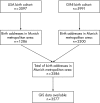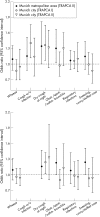Respiratory health and individual estimated exposure to traffic-related air pollutants in a cohort of young children
- PMID: 16912084
- PMCID: PMC2092590
- DOI: 10.1136/oem.2006.028241
Respiratory health and individual estimated exposure to traffic-related air pollutants in a cohort of young children
Abstract
Objectives: To estimate long-term exposure to traffic-related air pollutants on an individual basis and to assess adverse health effects using a combination of air pollution measurement data, data from geographical information systems (GIS) and questionnaire data.
Methods: 40 measurement sites in the city of Munich, Germany were selected at which to collect particulate matter with a 50% cut-off aerodynamic diameter of 2.5 microm (PM2.5) and to measure PM2.5 absorbance and nitrogen dioxide (NO2). A pool of GIS variables (information about street length, household and population density and land use) was collected for the Munich metropolitan area and was used in multiple linear regression models to predict traffic-related air pollutants. These models were also applied to the birth addresses of two birth cohorts (German Infant Nutritional Intervention Study (GINI) and Influence of Life-style factors on the development of the Immune System and Allergies in East and West Germany (LISA)) in the Munich metropolitan area. Associations between air pollution concentrations at birth address and 1-year and 2-year incidences of respiratory symptoms were analysed.
Results: The following means for the estimated exposures to PM2.5, PM2.5 absorbance and NO2 were obtained: 12.8 microg/m3, 1.7x10(-5) m(-1) and 35.3 mug/m3, respectively. Adjusted odds ratios (ORs) for wheezing, cough without infection, dry cough at night, bronchial asthma, bronchitis and respiratory infections indicated positive associations with traffic-related air pollutants. After controlling for individual confounders, significant associations were found between the pollutant PM2.5 and sneezing, runny/stuffed nose during the first year of life (OR 1.16, 95% confidence interval 1.01 to 1.34) Similar effects were observed for the second year of life. These findings are similar to those from our previous analysis that were restricted to a subcohort in Munich city. The extended study also showed significant effects for sneezing, running/stuffed nose. Additionally, significant associations were found between NO2 and dry cough at night (or bronchitis) during the first year of life. The variable "living close to major roads" (<50 m), which was not analysed for the previous inner city cohort with birth addresses in the city of Munich, turned out to increase the risk of wheezing and asthmatic/spastic/obstructive bronchitis.
Conclusions: Effects on asthma and hay fever are subject to confirmation at older ages, when these outcomes can be more validly assessed.
Conflict of interest statement
Competing interests: None declared.
Comment in
-
The use of GIS to evaluate traffic-related pollution.Occup Environ Med. 2007 Jan;64(1):1-2. doi: 10.1136/oem.2006.030080. Occup Environ Med. 2007. PMID: 17189451 Free PMC article.
-
A novel hypothesis to explain traffic-related nocturnal cough.Occup Environ Med. 2008 Aug;65(8):575. doi: 10.1136/oem.2007.038711. Occup Environ Med. 2008. PMID: 18653775 No abstract available.
Similar articles
-
Effects of long-term exposure to traffic-related air pollution on respiratory and cardiovascular mortality in the Netherlands: the NLCS-AIR study.Res Rep Health Eff Inst. 2009 Mar;(139):5-71; discussion 73-89. Res Rep Health Eff Inst. 2009. PMID: 19554969
-
Evaluating heterogeneity in indoor and outdoor air pollution using land-use regression and constrained factor analysis.Res Rep Health Eff Inst. 2010 Dec;(152):5-80; discussion 81-91. Res Rep Health Eff Inst. 2010. PMID: 21409949
-
The London low emission zone baseline study.Res Rep Health Eff Inst. 2011 Nov;(163):3-79. Res Rep Health Eff Inst. 2011. PMID: 22315924
-
[Health risk assessment of traffic-related air pollution near busy roads].Rev Epidemiol Sante Publique. 2012 Aug;60(4):321-30. doi: 10.1016/j.respe.2012.02.007. Epub 2012 Jul 4. Rev Epidemiol Sante Publique. 2012. PMID: 22770751 Review. French.
-
Air Pollution and Potential Health Risk in Ostrava Region - a Review.Cent Eur J Public Health. 2016 Dec;24 Suppl:S4-S17. doi: 10.21101/cejph.a4533. Cent Eur J Public Health. 2016. PMID: 28160532 Review.
Cited by
-
Proximity to Major Roads and Risks of Childhood Recurrent Wheeze and Asthma in a Severe Bronchiolitis Cohort.Int J Environ Res Public Health. 2021 Apr 15;18(8):4197. doi: 10.3390/ijerph18084197. Int J Environ Res Public Health. 2021. PMID: 33921001 Free PMC article.
-
Evaluation of Pollutants Along the National Road N2 in Togo using the AERMOD Dispersion Model.J Health Pollut. 2020 Aug 25;10(27):200908. doi: 10.5696/2156-9614-10.27.200908. eCollection 2020 Sep. J Health Pollut. 2020. PMID: 32874764 Free PMC article.
-
Prevalence of cough throughout childhood: A cohort study.PLoS One. 2017 May 24;12(5):e0177485. doi: 10.1371/journal.pone.0177485. eCollection 2017. PLoS One. 2017. PMID: 28542270 Free PMC article.
-
The odds of developing asthma and wheeze among children and adolescents exposed to particulate matter: asystematic review and meta-analysis.BMC Public Health. 2025 Mar 31;25(1):1225. doi: 10.1186/s12889-025-22382-3. BMC Public Health. 2025. PMID: 40165124 Free PMC article.
-
Long-term impacts of prenatal and infant exposure to fine particulate matter on wheezing and asthma: A systematic review and meta-analysis.Environ Epidemiol. 2019 Apr 12;3(2):e042. doi: 10.1097/EE9.0000000000000042. eCollection 2019 Apr. Environ Epidemiol. 2019. PMID: 33778337 Free PMC article. Review.
References
-
- World Health Organization WHO air quality guidelines global update 2005. Report on a working group meeting, Bonn, Germany. Geneva: WHO, 2005
Publication types
MeSH terms
Substances
LinkOut - more resources
Full Text Sources



